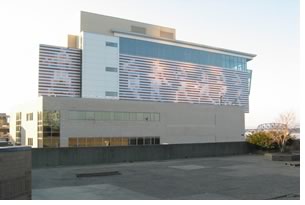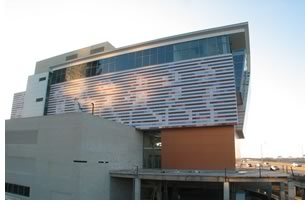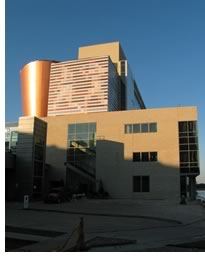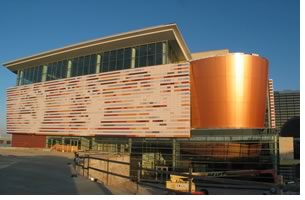

2/2006

by Russell Boniface
Associate Editor
“Champions aren’t made in the gyms. Champions are made from something they have deep inside them—a desire, a dream, a vision.”
—Muhammad Ali
 The architecture of the new Muhammad Ali Center in Louisville by Beyer
Blinder Belle pulls no design punches to reflect the humanism and ideals
of the boxing champion who once called himself “The Greatest.”
The architecture of the new Muhammad Ali Center in Louisville by Beyer
Blinder Belle pulls no design punches to reflect the humanism and ideals
of the boxing champion who once called himself “The Greatest.”
The six-level, 96,000-square-foot Muhammad Ali Center, bordering the Ohio River in the downtown section of the city where Muhammad Ali was born, does more than celebrate Ali’s athletic skill and outspoken personality. Built also as an interactive cultural and educational institution, the Muhammad Ali Center shares and teaches Muhammad Ali’s beliefs in hope, understanding, and personal best, challenging the “greatness” of people through awareness and inspiration.
More than memorabilia
A controversial political figure in the 1960s, Muhammad Ali
always had strong personal convictions. Since retiring, Ali, 63, has
devoted himself to humanitarian endeavors and education efforts around
the globe, encouraging people to have goals and to respect and better
understand one another. As an Ali museum was being discussed, it was
Ali himself who said he wanted more than a museum, stating, "For
many years I have dreamed of creating a place to share, teach, and
inspire people to be their best and to pursue their dreams."
 The
$80 million Muhammad Ali Center opened last November and was founded
by Ali and his wife Lonnie. The construction was funded by private donations,
and the land donated by the City of Louisville. The Ali Center has 21,000
square feet of interactive exhibits, arranged around a skylighted, multilevel
atrium space. There is also a 2,100-square-foot auditorium, two galleries
totaling 4,100 square feet, an education center, theaters, distance-learning
facilities, an archive and library, and 8,000 square feet of multipurpose
event rooms on the top floor overlooking the Ohio River. A two-level,
40,000-square-foot outdoor plaza, also facing the Ohio River, will complete
the project in the fall of 2006 and be adjacent to the Kentucky Center
for the Arts.
The
$80 million Muhammad Ali Center opened last November and was founded
by Ali and his wife Lonnie. The construction was funded by private donations,
and the land donated by the City of Louisville. The Ali Center has 21,000
square feet of interactive exhibits, arranged around a skylighted, multilevel
atrium space. There is also a 2,100-square-foot auditorium, two galleries
totaling 4,100 square feet, an education center, theaters, distance-learning
facilities, an archive and library, and 8,000 square feet of multipurpose
event rooms on the top floor overlooking the Ohio River. A two-level,
40,000-square-foot outdoor plaza, also facing the Ohio River, will complete
the project in the fall of 2006 and be adjacent to the Kentucky Center
for the Arts.
Floats like a butterfly
New York City-based Beyer Blinder Belle Architects & Planners, LLP,
was commissioned to create the Ali Center. Frederick Bland, FAIA, served
as the principal in charge. “We worked closely with Ali Center
President and Chief Executive Officer Mike Fox, who wanted the building
to be impressive but not self-referential or grandiose. Muhammad and
Lonnie Ali also felt that was the right thing to do. It was also important
to have it open, inviting, and sending out clues to the world to come
in. The man is a public man, so the center has to be a public world.”
Bland explains the building’s dual roles. “It certainly needs to interpret the life of Muhammad Ali, but in addition the building plays an important role in downtown Louisville,” he says. “It mediates the historic downtown with the Ohio River. The lower masonry of the building relates to the surrounding 19th-century buildings, while the upper portion frees itself of that context and reaches north to the ‘unknown’ to free itself from the context of the city, much like Ali, who set himself apart.”
 The building uses natural light strategically to protect its exhibits. “The
strategic placement of glass windows was critical,” says Bland. “We
had to flood the areas where we could have natural light. But then, going
back to the idea of inviting people in, wanted the glass to act as a
beacon to send out artificial light at night.” Next was the “wrapper” on
all four sides of the building—1 x 1 terra-cotta tiles in nine
colors ranging from oranges to blues to cream. The tiles form abstract
representations of well-known press images of “The Champ.” On
the east-facing side, for example, the reflective exterior tiles depict
Muhammad Ali boxing, such as doing his trademark “Ali shuffle.”
The building uses natural light strategically to protect its exhibits. “The
strategic placement of glass windows was critical,” says Bland. “We
had to flood the areas where we could have natural light. But then, going
back to the idea of inviting people in, wanted the glass to act as a
beacon to send out artificial light at night.” Next was the “wrapper” on
all four sides of the building—1 x 1 terra-cotta tiles in nine
colors ranging from oranges to blues to cream. The tiles form abstract
representations of well-known press images of “The Champ.” On
the east-facing side, for example, the reflective exterior tiles depict
Muhammad Ali boxing, such as doing his trademark “Ali shuffle.”
Visitors arriving from the north see an image of Muhammad Ali lighting the torch at the 1996 Summer Olympic Games, and from the west there is an image of his very identifiable face. Says Bland, “This geometrical collection of tiles at close range appears to be just an interesting but incoherent collection of tiles, causing people to perhaps ponder what the architect could have possibly had in mind. From further away, though, especially by car or river boat, the building tiles operate effectively as a billboard, becoming coherent and powerful images of Ali.” The tile design also evokes Ali’s boldness, humanitarianism, and approachability.
Sixteen hundred tons of steel were used in construction. Atop a two-story, elliptical lobby on the building’s south side sits a three-story cone made of aluminum panels with a copper hue, which represents the torch carried by Muhammad Ali at the Olympics. (Ali also was a gold medalist at the 1960 Olympics.) Within the torch is an elliptical staircase connecting the main exhibition floors. A curved skylight over the lobby at the base of the torch allows one to look upward into the torch from below. “The torch is a key part of the entry experience,” Bland points out. “We needed to enclose portions of the exhibit and decided to do it in a way that would evoke one of the many times Ali reinvented his career and his life.”
 The butterfly roof recalls Ali’s famous quote about his boxing
skills, “Float like a butterfly, sting like a bee. Your hands can't
hit what your eyes can’t see.” It “lifts off” from
a lower center ridge. The roof caps a glass-enclosed sixth floor where
there are multipurpose event rooms. “The torch and roof analogy
are subtle enough to fit in with an overall architectural vocabulary
rather than a theme-architectural vocabulary,” explains Bland. “The
butterfly also provides for bigger windows at the top of the building
that allow for a great vista of the sky and river, as well as rooms with
unique settings.”
The butterfly roof recalls Ali’s famous quote about his boxing
skills, “Float like a butterfly, sting like a bee. Your hands can't
hit what your eyes can’t see.” It “lifts off” from
a lower center ridge. The roof caps a glass-enclosed sixth floor where
there are multipurpose event rooms. “The torch and roof analogy
are subtle enough to fit in with an overall architectural vocabulary
rather than a theme-architectural vocabulary,” explains Bland. “The
butterfly also provides for bigger windows at the top of the building
that allow for a great vista of the sky and river, as well as rooms with
unique settings.”
Beyer Blinder Belle is also working to design a 40,000-square-foot, two-level plaza, with nationwide EDAW, Inc. When completed, this year, the plaza will expand the entrance and be connected by an area of amphitheater-style seating. The upper level is designed to be “a relaxing environment” with a water wall and quiet reflecting pool. The lower level will be “a more active gathering place” and feature a sculptural glass fountain. As water flows from the upper level through the amphitheater to the lower level, gaining speed and energy, it will symbolize, according to the center, “the cumulative force of Muhammad Ali’s influence, from the individuals he has touched to the world at large.”
Inside the ropes
The Ali Center has a lot in its corner. If people come simply to "see
boxing stuff,” however, they could be disappointed. Instead, a
focus on self-discovery and personal growth are the Ali Center’s
primary jab.
 The
Center refers to a visitor experience as “nontraditional” since
its main focus is not memorabilia. For example, visitors can go through
theme-based pavilions, each using photos, film, music, and exhibits to
showcase an Ali value he feels strongly about—six different Ali
values in all: respect, dedication, confidence, conviction, giving, and
spirituality. Each of the six “stations” is designed to tell
viewers something about Ali and also themselves. A trip to the “spirituality” pavilion
provides quotations from holy books of various religions and talks about
Ali’s conversion to Islam, while the “confidence” pavilion
showcases the turbulent 1960s, when Ali's beliefs on religion and civil
rights, including his challenge of the Vietnam War, made him a lightning
rod of public opinion. Visitors experience that decade, then have a chance
to explore their own convictions.
The
Center refers to a visitor experience as “nontraditional” since
its main focus is not memorabilia. For example, visitors can go through
theme-based pavilions, each using photos, film, music, and exhibits to
showcase an Ali value he feels strongly about—six different Ali
values in all: respect, dedication, confidence, conviction, giving, and
spirituality. Each of the six “stations” is designed to tell
viewers something about Ali and also themselves. A trip to the “spirituality” pavilion
provides quotations from holy books of various religions and talks about
Ali’s conversion to Islam, while the “confidence” pavilion
showcases the turbulent 1960s, when Ali's beliefs on religion and civil
rights, including his challenge of the Vietnam War, made him a lightning
rod of public opinion. Visitors experience that decade, then have a chance
to explore their own convictions.
Other exhibits include the “Walk with Ali” interactive program that allows visitors to identify their signature character strengths and receive “life coaching” tips from psychologists and Ali himself, through interactive displays; “Lighting the Way,” a theater with 16 torches activated by touch that allow a visitor to become part of the Ali torch ceremony (it is accompanied by a 12-minute video of Ali and others talking about the importance of conviction and caring); and the 55-foot-long “Hopes and Dreams Wall”—made from children's drawings—with 8,000 3x3-inch wooden tiles with messages by children from 140 countries. Puzzles accompanying the wall provide advice on breaking those big dreams into smaller goals.
“I think the exhibits are among the best I’ve ever seen for a place like this,” maintains Bland. “There’s an overall architectural consistency. It flows well, there is a nice color palette, it’s dense, and the subject matter is interesting. It’s definitely not a sports museum.”
 Going the distance
Going the distance
But sports and artifact fans shouldn’t throw in the towel. Items
on display include Ali boxing gear, such as gloves and robes; the torch
he used to light the Olympic torch; and the jewel-studded robe bearing
the inscription "The People's Choice," a gift from Elvis Presley.
Multimedia exhibits include films and video highlights of 15 Ali fights,
including matches against Sonny Liston, George Foreman, and Joe Frazier,
which climaxed with the grueling "Thrilla in Manila" in 1975;
and broadcast interviews, particularly those with sportscaster Howard
Cosell. And the “Training with Ali” exhibit, designed like
Ali's training camp, has a regulation boxing ring with holographic images
of Ali that jab and throw uppercuts to teach the rudiments of shadow
boxing, the speed bag, and the heavy bag. The “camp” even
has punching bags where visitors can measure their strength compared
with Ali's. The library and archive contain Ali-related documents, including
fight contracts, correspondence, speeches, books, tapes, and clippings.
There is also a 13-minute film entitled The Greatest, produced for the center and narrated by Samuel L. Jackson, shown on a 20-foot boxing ring. Additional displays include those of Ali's writing and poetry, a photo gallery of Ali, and an art exhibit area featuring reproduction paintings and drawings of Ali.
The Muhammad Ali Center has a continuing campaign to raise $20 million more to establish an endowment to cover its operating costs. Four-hundred thousand annual visitors are predicted.
“A big part of making the center was that it be an active part of the city’s daily life,” Bland says. “I think the Muhammad Ali Center will be a vital part of the future of Louisville, and a key new generator of its downtown.”
Copyright 2006 The American Institute of Architects.
All rights reserved. Home Page ![]()
![]()
If
you go . . .
The Muhammad Ali Center is on Sixth Street between Louisville's Main Street
and River Road. The center is open Monday-Saturday 9:30 a.m. to 5 p.m.;
Sunday, noon to 5 p.m. Call 502-992-5306 or visit the Center Web site. ![]()
Fred Bland thanks Bravura Corporation, Louisville, and its many AIA members for its role as the local liaison on this project.
![]()